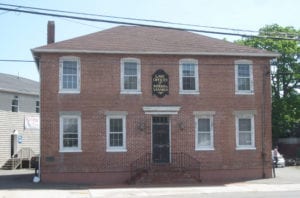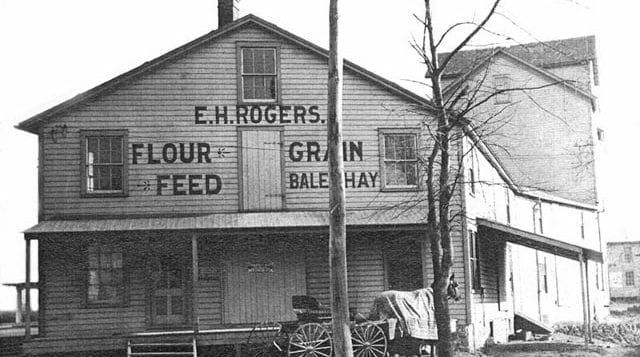Port Jeff area historical societies want old buildings preserved as part of revitalization
Revitalization plans between the train tracks and Route 347 in Port Jefferson Station have an eye toward the future, but those who have dedicated their lives to the community’s history have a message: not so fast.
Five buildings with historical roots in Port Jefferson Station that fall squarely within the bounds of Town of Brookhaven’s territory slated for redevelopment, as indicated during its planning board’s July 24 presentation during a Port Jefferson Station/Terryville Civic Association meeting, could be at risk of being demolished. Two of the buildings, 101 and 105 Main St., adjacent to the south side of the train tracks, could be in more imminent danger, according to Jack Smith, president of Cumsewogue Historical Society, based on a phone call he said he had in March with Charlie Lefkowitz, a real estate developer who owns many of the buildings in the area personally or in part with business associates.

The buildings, dating from the early 1900s, one of which housed E.H. Rogers Feed Mill, serve as links back to the area’s agricultural roots, according to Smith.
“We worked with the community and town for several years,” Lefkowitz said in a phone interview about the proposed redevelopment as a whole, though he declined to comment specifically on the historical buildings other than to confirm he spoke with Smith in March. “We will continue to work with the community and the town to create the best product and vision for Port Jefferson Station.”
In 2014, the findings of the Port Jefferson Station Commercial Hub Study commissioned by the town to compile community feedback and detailed analysis from professionals to determine what redevelopment of the area might entail were released to the public. Though the study has no legal bindings, it contains recommendations from Port Jefferson-based architects and consultants for the study, Campani and Schwarting Architects founders Frances Campani and Michael Schwarting, as well as longtime Suffolk County planner Lee Koppelman, calling for the preservation and incorporation of the five buildings into future redevelopment plans.
Smith said Lefkowitz told him the two buildings nearest the train tracks specifically are in a state of disrepair and cannot be preserved, despite the fact that they are occupied by businesses currently. Smith said the developer was willing to preserve relics from the historical structures and even establish a museum to memorialize the history, which Smith called “nonsense” and “insulting.” Schwarting said he disagreed with Lefkowitz’s assertion, relayed to him by Smith during a joint interview July 20.
“They’ve got good bones,” the architect said of the buildings.
Schwarting’s partner Campani said she understood the dilemma developers like Lefkowitz face in situations like these, though she agreed she does not see a case for needing to knock the buildings down rather than refurbishing them and incorporating them into revitalization plans.
“These buildings should be celebrated not simply demolished.”
— Nick Acampora
“Part of the problem, which is one of the things we tried to address in the study, is that it’s not a very pedestrian-friendly area right now, and you sort of have to slow down to a pedestrian pace to start to appreciate these things,” Campani said. “If you’re flying by at 40 miles per hour, you’re not going to.”
Sarah Kautz, preservation director of Preservation Long Island, a nonprofit that advocates for the protection and stewardship of historic sites, said the buildings’ location on a state road and proximity to a Long Island Rail Road station would trigger review by New York State as part of the State Environmental Quality Review Act prior to demolition, though getting the sites listed on state or national historic registries would go a long way toward securing their protection.
“It doesn’t prevent [demolition], but it does put it on a longer path, and it can bring private owners to the table in a serious way and kind of leverage a little bit of a negotiation,” she said, adding that public support and collaboration between the two historical sites would ultimately serve as strong deterrents against the approval of any plans ultimately necessary from the town’s planning board when a site plan is eventually weighed. Kautz said the organization would support a push to preserve the buildings. “They’re important buildings. The local community will benefit more from a rehab than it would by a total blitz.”
Nick Acampora, president of the Historical Society of Greater Port Jefferson, pledged to support Smith in his efforts, even if it comes to “laying down in front of a bulldozer.”
“These buildings should be celebrated not simply demolished,” Acampora said.







